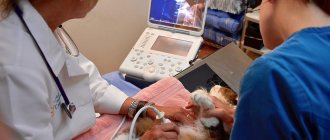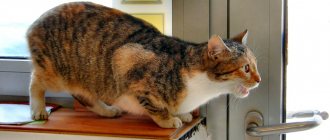Cat pregnancy is the period from conception to birth and is a significant and responsible part of the animal’s life. Its owner must carefully care for the cat and take care of its well-being.
The gestation period in cats will help you find out the estimated due date. Each cat's pregnancy progresses differently; birth may be premature or, conversely, delayed.
The length of pregnancy depends on several factors - the number of kittens being carried, the individuality of her body and age. The average period of normal pregnancy for a cat is 64-67 days (about 9 weeks).
Signs of pregnancy in a cat
Only a veterinarian or an experienced breeder can determine pregnancy in the earliest stages. After mating, pregnancy can occur within two to three weeks. Then obvious signs will appear.
At first, the furry pet’s body receives a large dose of hormones, so the nipples swell and turn pink. This happens already 2 weeks after mating. After three to four weeks, a radical restructuring of the body occurs. The animal's activity decreases and nausea may even be present.
After just 7 days, the pet sleeps and eats a lot. Now the animal needs additional nutrients to form embryos. It makes sense to give special vitamins for pregnant cats, which the veterinarian will recommend.
The taste preferences of the expectant mother change, and you may notice mood swings. After 6 weeks, a large belly becomes noticeable, the animal’s movements slow down, and its gait may change.
Assistance during childbirth
A confident person or an experienced breeder can help during childbirth. Weak contractions, incorrect positioning of the fetus or its large size, lack of pushing - all this requires outside help. In terms of time, the birth process itself can last 3–16 hours, depending on the number of kittens, their size and other factors.
Stimulating contractions with drugs is allowed only under the supervision of a doctor. In other cases, there are safe methods:
- circular abdominal massage;
- inserting a finger 3–4 cm into the vagina with a gentle massage of its lower wall;
- nipple massage;
- a cat eating the placenta (baby place);
- applying to the kitten's nipple.
If the cat does not chew the umbilical cords of the babies, you need to help her. For this:
- the umbilical cord contracts at a distance of 2–3 cm from the kitten;
- Its compression continues for 15–20 seconds to block the vessels;
- cutting the umbilical cord with blunt scissors;
- bandaging at a distance of 1.5 cm from the kitten;
- treating the cut area with brilliant green or alcohol tincture.
The kitten's lack of breathing implies the need for resuscitation. The first step is to remove amniotic fluid and mucus from the nose and mouth. For this procedure you will need an ordinary syringe. Next, use a piece of gauze or a napkin to wipe the body with massage movements in the direction from the tail to the head.
If time passes and no signs of life appear, shaking will help. To do this, pick up the kitten, hold its head, and shake it (like a thermometer). This is followed by wiping, mouth-to-nose artificial respiration and repetition of the manipulation. A favorable outcome can be determined by a squeak or the appearance of breathing.
A pregnant cat in the house is a great joy and no less a great responsibility for the owners. You must be sure that the development process is proceeding correctly, without pathologies and deviations, and be ready to provide your pet with the necessary help at any stage of pregnancy.
I like it I don't like it
How long does pregnancy last in cats?
Many breeders are concerned with the question, how many months does a cat’s pregnancy last in general? It lasts only up to 9 weeks – that’s about 65 days. There may be differences in the gestation period due to the characteristics of the breed or a particular individual. Thus, long-haired cat breeds bear kittens for about 10 weeks, while short-haired cats have a gestation period of about 9 weeks. The duration of pregnancy in outbred cats will depend on the standard of living and quality of nutrition.
A cat can bear kittens up to 3 times a year, but this is a lot of stress for the body. Such frequent births simply wear out the body, so it is not recommended to breed a cat more than once a year.
The birth itself begins with contractions, the whole process takes less than a day, usually 3-4 hours. After contractions and pushing, the fetus will appear in the bladder. The animal gnaws the umbilical cord and may eat the afterbirth. After this, the newborn kitten begins to eat, and the mother continues the birth process.
When do you need a veterinarian?
Usually a healthy cat copes with the birth of kittens quite independently. But you may need help from a veterinarian if:
- Murka carried kittens for more than 70 days;
- More than 20 hours have passed since the contractions began, and the kitten has not appeared;
- strong labor contractions last more than 20 minutes, but labor does not occur;
- a kitten or amniotic sac is stuck in the birth canal;
- profuse, bright red, bloody or dark, foul-smelling discharge appears from the vagina.
And it also happens that cats bear up to 14 kittens. But with such a very multiple pregnancy, all the kittens never remain alive. So, if a cat decides to give birth ahead of schedule, owners do not need to be upset - most likely, this will not be her last pregnancy.
Diagnosis of pregnancy
To prepare for an important event, you need to understand your pet's gestation period. The period is determined by the external signs that the cat’s body shows. On days 16-18, the nipples become a bright coral color. Also, due to decreased activity and frequent feeding, the cat’s weight increases. But you need to make sure that this is really pregnancy, and not a consequence of the development of parasites in the body.
Therefore, you should definitely undergo a veterinary examination:
- Palpation. An experienced veterinarian can feel the embryos as early as the third week and determine the cat’s gestational age, and closer to the sixth week he can tell how many kittens there will be.
- X-ray. This method is used extremely rarely, as it can harm the embryos, but sometimes you can’t do without it.
- Ultrasound. The simplest method, which is used everywhere and helps to track whether there are any developmental disorders in kittens.
Preparing for childbirth
The gestation period in cats is short, but sufficient to prepare everything necessary for the birth of fluffy babies. Already at the initial stage of pregnancy, think about where exactly your pet will give birth.
Set aside a cozy, personal space and build a “nest” from a low box. Cut off the fourth wall to make it easier to communicate with the cat during birth. The box should be spacious enough to accommodate both the mother and the growing offspring. Cover the box with newspapers or a thick diaper. It is not advisable to lay ordinary fabric, because... Kittens can get entangled in it.
Place the cat inside so that it gets used to it and gets used to it. The pet may not like the constructed place, and it will begin to “nest” in the closet or behind the sofa. Do not scold the cat for this behavior, but gently invite it to the designated place. Place the box in a corner, in an enclosed space but where you can easily access it.
Make arrangements for the birth with your veterinarian in advance. If a specialist cannot come and help in person, then leave a phone number handy for emergency consultation.
How to properly care for a pregnant cat?
First, you need to make sure your cat is getting enough nutrition. As mentioned above, she may eat more than usual during this time. When half the term has passed, the owner, on the contrary, will need to introduce some dietary restrictions: the amount of food should be reduced in portions, and the intervals between feedings should be reduced.
If feeding the cat consisted of natural food, then you need to add a large amount of cottage cheese and kefir - the animal’s body needs calcium. You can also choose specialized food for pregnant cats.
The veterinarian will advise on the need for vitamin or mineral supplements after examining the pet. It is important for the animal to remain in good physical shape, so do not deny it moderately active games.
Care must be taken to ensure that the cat does not contract any infection. Therefore, it is important to protect her from communicating with other cats, especially those that constantly live outside. The cat may become infected with worms and become more aggressive, which can lead to fights and injuries.
The pet needs to be examined daily - any deviation from the norm should alert the owner. The reason to visit a veterinary clinic may be the cat’s weakness, refusal to eat long before the due date, or excessive vaginal discharge.
Gestation course, number and development of fetuses
How does gestation proceed in cats? Regardless of how many days they carry the cubs, in the absence of any deviations, this process follows a standard scenario. Conventionally, this period can be divided into 4 stages:
- 3–4 weeks;
- 5–6 weeks;
- 7–8 weeks;
- 9–10 weeks.
In the first weeks of gestation, the cat's behavior practically does not change. At this time, the process of attachment of the embryos to the wall of the uterus and the formation of vital organs in their body takes place.
Active development of kittens begins at 3 weeks. Information about how cats bear offspring and what happens to the cubs during this period is presented in the table:
| Gestation period, weeks | Changes occurring in the cat and cubs | Fruit size, cm |
| 3–4 |
| 4 |
| 5–6 |
| 6 |
| 7–8 |
| 9,5 |
| 9–10 |
| 12,5 |
During the first pregnancy, most pets give birth to 1 to 3 cubs. Mature females usually give birth to 6–8 kittens. In addition to age, how many kittens a cat can give birth to is influenced by breed, heredity, length of gestation, health characteristics, lifestyle and living conditions, as well as quality of nutrition.
How to prepare a place for offspring?
During childbirth, the animal feels calmer in a quiet, secluded place, so you need to prepare a bed or box in advance. The peace of the last two weeks depends on the behavior of all household members. Young children especially should not fuss while waiting for a kitten, this will make the cat nervous.
Over time, you need to accustom the animal to a new resting place. But it also happens that for some reason the cat does not like the bed, then you just need to track where the animal tries to hide during childbirth.
Order pet products in Krasnoyarsk from the Pharmacia online pharmacy. Ordering products through online search is available with a discount of up to 10%.











